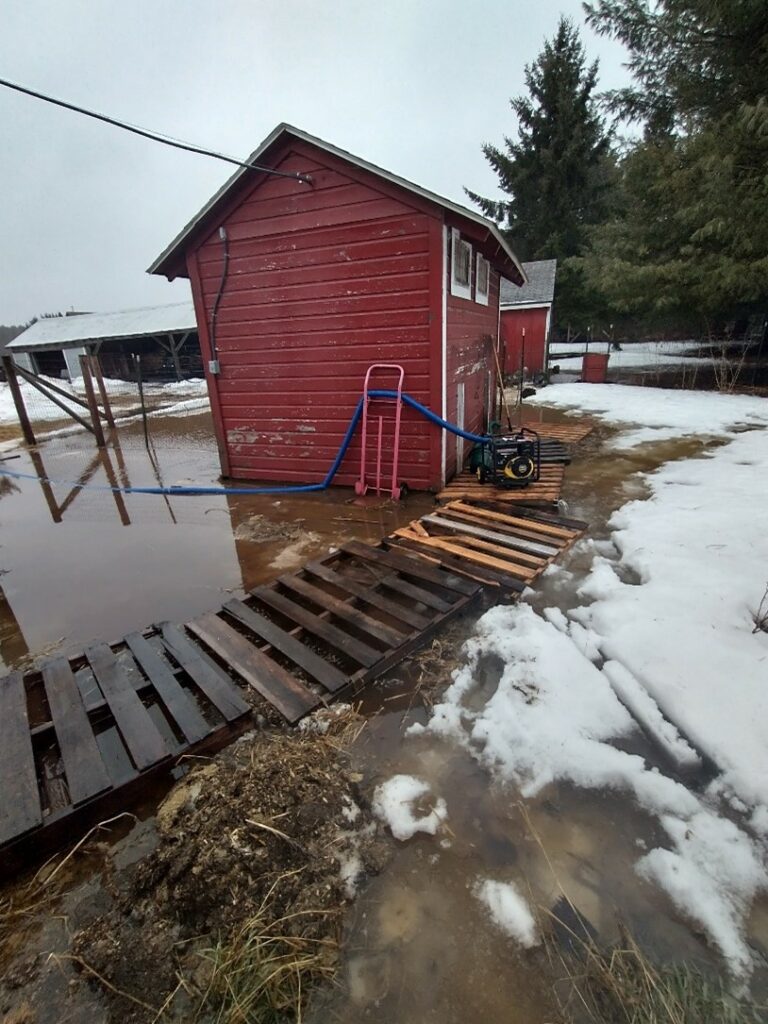The Great Melt

Snow. We’ve certainly had an epic dose of it this year! Piles grew so high in the barnyard that they were taller than buildings. Paths grew narrower and narrower, and it was a nearly full-time task to keep enough off our roofs to prevent collapsing.
Until quite recently, all that snow was still here, with temperatures dipping below zero at night, in April! This week, however, spring decided to arrive all at once. The great melt was here in earnest.
The wild birds knew. Within the span of one week, robins, sandhill cranes, red-winged blackbirds, mourning doves, and juncos all arrived. They had been waiting for the grand melt as well, ready for the earth to awaken and stretch from her winter’s slumber.
With super snowy winters, I hope for a kind, gradual melt. We’ve had springs where heavy rains poured down on thick snow, which created instant flooding on our farm. With the ground still frozen, the water has nowhere to go, and it pools and puddles and seeps into buildings and washes out the lane. There has been many a spring we’ve needed to park our vehicles on the other side of the creek, as the rushing waters overrun the culvert and go right over the road! That makes an interesting commute to Farmstead Creamery in the morning—better hope there are no cracks in your chore boots!
As temperatures warm rapidly this week, we’ve been quite concerned that such a flooding fate might await us this year, but so far (fingers crossed), it’s been remarkably less flood-ish than usual. This is likely in part because of the unique way the snow and cold manifested this year, with tons of snow starting in at the Holiday. In contrast, the polar vortex came later, instead of the other way around as has been the case in previous years.
Having so much snow early meant that the ground underneath wasn’t frozen hard before it became heavily blanketed in snow, acting as an insulator. That insulation stayed and never melted away, keeping the thick snowy blanket on the soil. We’ve started digging our overwintered carrots, which were covered in mulch in the fall and then by snow throughout the winter. The carrots become crisp and sweet with this process and are a great treat in the early spring.
Often, when we start digging the carrots, they are embedded in clods of frozen soil, despite our mulching efforts. This year, however, after shoveling off the snow, the ground underneath wasn’t frozen at all, and the carrots dug up comparatively easy! They also did not show the damage to their tops that freezing can cause. That snow blanket really had worked well this year!
That same blanket of snow likely kept frost from penetrating deep into the soil all over the farm. Thankfully, we are on sand, so as the sun melts the snow, for the most part, it’s been able to sink into the ground as well. Puddles arrive, then drain away. Hopefully, if we’re lucky, that trend will continue, and we’ll avoid epic flooding and arduous pumping of water we’ve experienced in previous springs.
As the heaps of snow recede, items appear we haven’t seen in months. My yarn bombed peace pole has been completely buried in a shoulder-high pile of snow to the north of the canopy that protects our curbside pickup counter here at Farmstead Creamery. Just yesterday, the very top emerged. The crocheted dove of peace was all soggy and flat, its wings drooping down the sides of the pole as if thoroughly exhausted. I’d be exhausted too if I’d been compressed under that much snow for so long!
Spring thaw can create washouts on the farm as well. The lane from the barnyard to the creek slopes downwards and is the most direct route for water. In harsh thunderstorms, rivulets can wash out, which can also happen during the spring thaw. If the water really gets rolling, deep channels can be carved into the gravel. The warmth of the day followed by the chill of the night means that this thin river can freeze overnight, creating an ice-skating rink in the morning. We wear our cleats when walking this area when it’s frozen!
This morning, Kara shared with us a strange phenomenon that appeared on the lane between the barn and the machine shed. A football-sized hole emerged in the gravel. Prodding with a metal rod, she found that the size of the empty cavern underneath is much larger and wider, a real sinkhole. No driving there for a time! Once things dry out, we’ll have to excavate and repair it, so it’s safe to bring equipment through again.
Because the ground is not frozen, is so much water moving underneath the surface, that this sinkhole was created? I’m grateful we found the problem with our eyes, not because a piece of equipment is now stuck in a massive hole! It’s just one of those things that can happen at times like these.
With the great melt comes mud season, and then we know spring has truly arrived on the farm. Hoping that your transition from winter to spring is as smooth as possible, massive melt and all! See you down on the farm sometime.





